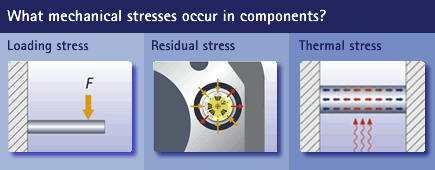
Profit from the benefits of experimental stress analysis
Optimally dimensioning the components for your products is the key to your success - regardless of whether you design or manufacture mobile phones, engines or airplanes.
- Gain increased safety, because you get components of higher quality
- Benefit from higher reliability, because components have a long service life
- Enhance your efficiency, because you only use the quantities of materials you actually need
How to measure stresses in components?
- Install the strain gages on the surface of the component
- Then use the measured strain to determine the mechanical stresses in the component
Experimental stress analysis enables mechanical stresses in components to be measured. These may have three causes: external forces, residual stresses, and thermal stresses.
Loading stress: Forces (loads) that are applied from outside cause material loading.
Residual stress: Internal forces in the material - without any external forces being involved - cause residual stresses. These can arise from non-uniform cooling of cast components, forging, or welding.
Thermal stress: Thermal stresses occur in systems in which parts with different thermal expansion coefficients are used. They can arise if free thermal expansion of the components is prevented or as a result of non-uniform heating.
For strength analyses, mechanical stresses have to be considered independent of their cause. Residual stress and thermal stress affect components in the same way as loading stress.
Depending on their absolute value and sign, they can substantially reduce a component’s loading capacity with respect to external loads.
What is Hooke’s Law?
In the elastic deformation range of materials, the methods of calculating the material stresses from the measured strains are based on Hooke’s Law. In its simplest form, Hooke’s Law is:
σ = ε · Ε
σ = material stress
ε = strain
Ε = modulus of elasticity of the material
This version of Hooke’s Law only applies to the uniaxial stress state. Other stress states require extended versions.


